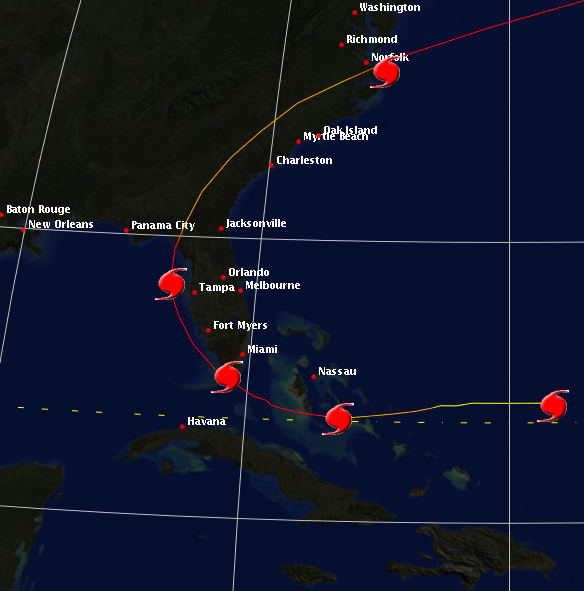The Labor Day Hurricane of 1935

The 2005 Atlantic Hurricane Season has had its share of monster hurricanes making big headlines and breaking records. Things were eerily similar on a Labor Day Weekend seventy years ago when what would become the “Storm Of The Century,” rolled through the Upper and Middle Florida Keys. The Labor Day Hurricane of 1935 set the standard for devastating United States hurricanes.
A Storm That Set the Standard: The Labor Day Hurricane of 1935
The Labor Day Hurricane of 1935 became the most powerful hurricane at the time, and the aftermath too, had its share of controversy. Unlike today, where a tropical storm or hurricane can be spotted easily on satellite and radar while Hurricane Hunter aircraft fly into the storm, The Labor Day Hurricane of 1935 went undetected for the most part until it was right on top of the Keys.
While the Weather Bureau, the predecessor to the National Weather Service and the National Hurricane Center, had improved somewhat since the deadliest disaster in United States History, the Great Galveston Hurricane of 1900, it still lacked the tools that modern forecasters benefit from today.
In addition, many of the forecasts were still done by hand as supposed to the plethora of numerical weather prediction models that are out there these days. Forecasters could still rely on ship reports, but they too, were hard to come by because many of the ships that were in the vicinity of such a storm did their best to get themselves out of harm’s way.
This article takes a look back at this powerful, but forgotten hurricane that occurred 70 years ago this past September. In addition to this article, we have a book review on a work written on this storm by Willie Drye called, Storm of the Century: the Labor Day Hurricane of 1935.
Much of the information that is used in this article comes from excerpts in that book as well as storm data from our Hurricaneville Info Center Storm Database and Eye of the Storm Tracking Software program, and interviews from a 1991 Weather Channel Video, Danger’s Edge.
Storm Facts: The Labor Day Hurricane of 1935
Looking at the facts, the Labor Day Hurricane of 1935 was the first ever Category Five Hurricane on record to hit the United States. It held the distinction of being the only Cat Five storm to hit the United States coastline for 34 years until Hurricane Camille roared ashore in August 1969.
Nevertheless, it still does hold the distinction of being the most intense hurricane to make landfall in the United States. Forming on August 29th, 1935, this monstrous hurricane was only the second named storm of the 1935 season, which was overall a fairly quiet season by most standards with six named storms the entire year.
Five of those storms went on to become hurricanes, and three of them became major hurricanes of Category Three strength or better on the Saffir-Simpson Scale. In addition, there was one Category Two Hurricane that year as well.
The Labor Day Hurricane, which was the longest-lasting storm of 1935 with a duration of 13 days, was a very small storm, on the order of Hurricane Andrew, which also had a similar path. Andrew moved just to the north of the Labor Day Hurricane’s track when both storms were near Florida while the Labor Day Hurricane hooked to the north much sooner than Andrew did.
The storm actually made two landfalls, both in Florida. The other landfall was in the area of the Big Bend region of Florida, where it came ashore as a Category Two Hurricane according to records from the NHC archives. Another interesting fact about this storm was how long it maintained hurricane strength.
The Labor Day Hurricane of 1935 was still a Category One Hurricane over a week after striking the Keys when it was beyond the Canadian Maritimes and heading into the much colder waters of the North Atlantic. The 1935 hurricane and Hurricane Andrew share some striking similarities.
As mentioned earlier, both were small storms in terms of their size. They both made two separate landfalls along the coast although Andrew went farther west before turning north, and still maintained major hurricane strength when it came ashore a second time in Louisiana. Both were Category Five Hurricanes and two of the only three such storms to strike the United States although Andrew didn’t become one until it was upgraded for its tenth anniversary in 2002.
As previously indicated, both had similar paths through the Bahamas and South Florida although Andrew came directly across South Florida while the Labor Day Hurricane of 1935 headed a bit to the Southwest before turning up into the Keys from the Southeast. They both created a firestorm of political controversy much like the 2005 crop of storms did. The similarities don’t end there as they were both among the first of their season’s storms, and powerful hurricanes in seasons that weren’t very active.
Like Katrina, Rita, and Wilma in 2005, the Labor Day Hurricane underwent explosive growth in a very short time. Only a mere fledgling tropical cyclone entering the Labor Day Weekend in September 1935, the Labor Day Hurricane rapidly intensified to the most intense hurricane on record at that time with a barometric pressure of 26.35 inches of Hg (Mercury), or 892 mb.
Winds were as high as 200 mph. The storm was so powerful that it singlehandedly destroyed the Overseas Railroad which was the vision of Henry Flagler in the early part of the 20th Century. The railroad was created to link the isolated Florida Keys with the mainland as well as the rest of the United States.
At the time, only about 1,000 people lived throughout the Keys. It was a secret spot for the rich and famous to get away from it all. Key West was the home for the prominent writer and adventurer, Ernest Hemingway.
The famous author, who was staunchly opposed to Roosevelt and his New Deal philosophy, would eventually write an essay dedicated to the World War I Veterans, who died on the Keys in the infamous hurricane. After the railroad had been completed, more people started coming down to the Keys, and finding out what the privileged had known for a long time. Pretty soon, the Florida Keys were no longer a secret.
Aftermath: The Labor Day Hurricane of 1935
After the storm had demolished the Keys, it then turned northward and made a second landfall in Florida’s Big Bend area. Then it spread heavy rains and wind into the Southeastern and Mid-Atlantic United States it killed several more people.
In all, the storm claimed about 400 lives although some South Florida papers of the period such as the Miami Tribune stated that as many as 1,000 perished in the powerful storm. One survivor of the storm, who has repeatedly told the tale of this great hurricane, Bernard Russell, lost the majority of his family that day.
The day before the storm, the Russell family was made up of 61 members. After the storm, there were only 11. The Russell family was one of the first families on the island. They received a land grant from the President in 1854. Even prominent politicians lost loved ones.

The legendary Claude Pepper, who made a name for himself in the United States Congress fighting for senior citizens, lost a nephew, who drowned with his companion in the storm surge that swept them into Florida Bay. Other prominent politicos had to endure controversy.
President Franklin Delano Roosevelt almost encountered similar stormy waters that President George W. Bush dealt with following the devastation and confusion of Hurricane Katrina, or Bush’s father, George H.W. Bush had in the wake of Hurricane Andrew.
Harry Hopkins, one of FDR’s top aides, stated that the reason for the loss of life on the Keys from the hurricane was due to inadequate warnings from the Weather Bureau. However, the Democrats control of Congress as well as the absence of social media and 24-7 cable news most likely saved FDR.
A Forgotten Storm of Yesteryear: The Labor Day Hurricane of 1935
Soon afterward, the Labor Day Hurricane of 1935 was swept under the rug much like the Long Island Express of 1938, and even Hurricane Katrina of 2005 did. Other events such as the assassination of Louisiana Senator and presidential candidate, Huey Long along with the Election of 1936 took over the headlines.
Similarly, in 1938, the Munich Agreement and the eventual annexation of Czechoslovakia by the Nazis made the Great Hurricane of ’38 a distant memory while in 2005, the unpopular war in Iraq, several Supreme Court nominations, riots in Argentina and France as well as protests in South Korea put the Katrina aftermath to the back pages. Meanwhile, seventy years after that terrible hurricane, the Keys still remain more vulnerable than ever.
The Overseas Railroad has been replaced by U.S. #1 in linking the Keys to the Florida mainland. The population was grown significantly over the years, and many truly do not comprehend how vulnerable this particular location is to a hurricane, nor do they fully understand the depth of the disaster that happened there nearly four score years ago.
Today, there are approximately 80,000 residents in the Keys with another 40,000 people that are part of the yearly tourist population during the summer. The head of emergency management for Monroe County, which covers the Florida Keys, Billy Wagner, has his hands full every year during hurricane season. He is constantly visiting the National Hurricane Center trying to absorb as much information as possible so that he can provide adequate warnings and evacuation orders that can get residents in his jurisdiction to safety.
The towns of Key West, Marathon, Islamorada, and Tavernier felt the wrath of all three Category Five Hurricanes in 2005 although they weren’t at that high level of intensity when they came through or near the Keys. Nevertheless, they were all intensifying storms when they passed through, and most notably, they caught many naive residents of these islands off guard.
Lucky for them, there weren’t many deaths and injuries from these storms. Next, to New Orleans, the Florida Keys are the most vulnerable location in the United States to a landfalling major hurricane. Much of the Keys is just several feet above sea level. So, it doesn’t even have to take a major hurricane to cause significant problems.
